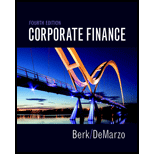
a)
To determine: Whether the expected return of the portfolio rises or falls when the correlation between JJ Company’s and W Company’s stock increases.
Introduction:
Expected return refers to a return that the investors expect on a risky investment in the future.
Portfolio refers to a set of financial investments owned by the investor. The portfolio of investments includes debentures, stocks, bonds, and mutual funds.
b)
To discuss: Whether the volatility of the portfolio rises or falls when the correlation between JJ Company’s and W Company’s stock increases.
Introduction:
Standard deviation refers to the deviation of the actual returns from the expected returns.
Want to see the full answer?
Check out a sample textbook solution
Chapter 11 Solutions
Corporate Finance Plus MyLab Finance with Pearson eText -- Access Card Package (4th Edition) (Berk, DeMarzo & Harford, The Corporate Finance Series)
- How does the time value of money affect investment decisions?arrow_forwardMr. Siya, the Chief Financial officer at WXZY Limited has noticed an increase in the company's stock returns variation over the last two financial years. He is interested in understanding the underlying influences on the company's stock returns. You have been tasked to perform a linear regression to understand whether the company's profit margins (independent variable) impact its stock returns. You have been provided with data for both the company's average monthly stock returns and profit margins over a 6-month period in 2022. Month July August September October November December Profit margins (x) Stock returns (y) 0.0263 0.0618 0.0389 0.1156 0.0158 0.0534 0.0461 0.1610 0.0030 0.0395 0.0393 0.1031 a) Calculate both the slope coefficient of the regression. b) Calculate the intercept of the regression. c) Calculate the unexplained/unexpected variation of the regression. d) Calculate the coefficient of determination. 6000 (2) (5) (3)arrow_forwardDo not answer wit incorrect values i will unhelpful!arrow_forward
- What are the implications of missing a credit card payment in finance?arrow_forwardOmni Advisors, an international pension fund manager, uses the concepts of purchasing power parity (PPP) and the International Fisher Effect (IFE) to forecast spot exchange rates. Omni gathers the financial information as follows: Base price level 100 Current U.S. price level 105 Current South African price level 111 Base rand spot exchange rate $ 0.188 Current rand spot exchange rate $ 0.171 Expected annual U.S. inflation 7% Expected annual South African inflation 5% Expected U.S. one-year interest rate 10% Expected South African one-year interest rate 8% Required: a. The current ZAR spot rate in USD that would have been forecast by PPP.Note: Do not round intermediate calculations. Round your answer to 4 decimal places. b. Using the IFE, the expected ZAR spot rate in USD one year from now.Note: Do not round intermediate calculations. Round your answer to 4 decimal places. c. Using PPP, the expected ZAR spot rate in USD four years from now.Note: Do not round intermediate calculations.…arrow_forwardDelta Company, a U.S. MNC, is contemplating making a foreign capital expenditure in South Africa. The initial cost of the project is ZAR11,000. The annual cash flows over the five-year economic life of the project in ZAR are estimated to be 3,300, 4,300, 5,290, 6,280, and 7,250. The parent firm's cost of capital in dollars is 9,5 percent. Long-run inflation is forecasted to be 3 percent per annum in the United States and 7 percent in South Africa. The current spot foreign exchange rate is ZAR per USD = 3.75. Required:. Calculating the NPV in ZAR using the ZAR equivalent cost of capital according to the Fisher effect and then converting to USD at the current spot rate. - NPV in USD using fisher effect Converting all cash flows from ZAR to USD at purchasing power parity forecasted exchange rates and then calculating the NPV at the dollar cost of capital. - NPV in USD using PPP rates Are the two USD NPs different or the same? What is the NPV in dollars if the actual pattern of ZAR per…arrow_forward
- What is the 50/30/20 budgeting rule in finance?arrow_forwardHow do student loans impact long-term financial health?arrow_forwardWith regard to foreign currency translation methods used by foreign MNCs, Multiple Choice a. foreign currency translation methods are generally only used by U.S. based MNCs since foreign firms have a built-in hedge by being foreign. b. are generally the same methods used by U.S.-based firms. c. are exactly the same methods used by U.S.-based firms since GAAP is GAAP. d. none of the options.arrow_forward
 Intermediate Financial Management (MindTap Course...FinanceISBN:9781337395083Author:Eugene F. Brigham, Phillip R. DavesPublisher:Cengage Learning
Intermediate Financial Management (MindTap Course...FinanceISBN:9781337395083Author:Eugene F. Brigham, Phillip R. DavesPublisher:Cengage Learning EBK CONTEMPORARY FINANCIAL MANAGEMENTFinanceISBN:9781337514835Author:MOYERPublisher:CENGAGE LEARNING - CONSIGNMENT
EBK CONTEMPORARY FINANCIAL MANAGEMENTFinanceISBN:9781337514835Author:MOYERPublisher:CENGAGE LEARNING - CONSIGNMENT


